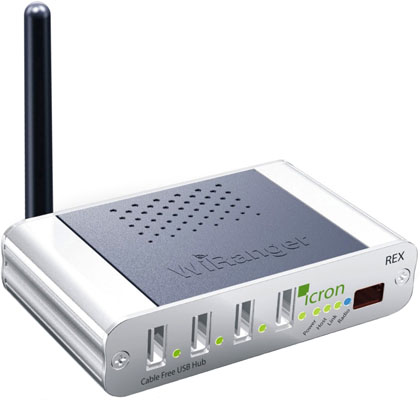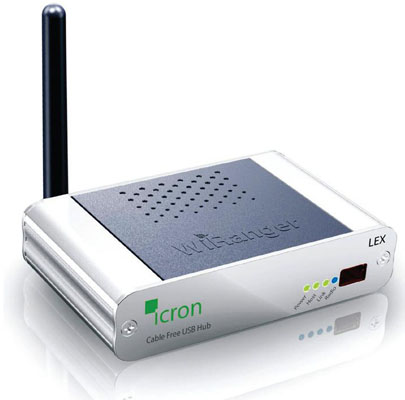Original URL: https://www.theregister.com/2007/09/10/review_wiranger/
Icron WiRanger Wi-Fi connected USB hub
USB-over-Wi-Fi, anyone?
Posted in Networks, 10th September 2007 11:53 GMT
Review The whole point of wireless is the freedom to connect to something from anywhere within an area rather than from a single, specific place. Icron's WiRanger wireless USB hub system stumbles at the first hurdle. Yes, its two units - the hub and the box that connects to your computer - link wirelessly, but both need mains-power feeds. Good for desktops, then, but not for a laptop-friendly experience.

Icron's WiRanger: the Rex module is a four-port hub
The first of the two WiRanger boxes - dubbed the Lex, for Local EXtender - is a small, metal unit with activity LEDs on the front and, round the back, an antenna, a printer-style USB port and the power connector. The Rex - the Remote EXtender - is almost identical: it lacks the rear USB port, but has four standard USB sockets on the front instead. Both are well made, with a solid, hand-built quality.
Icron promises true plug and play, and WiRanger delivers. Power up the Lex then connect it to a spare USB port on your computer and it's ready to go. Place the Rex up to 30m away, power it on, and the two units almost immediately register each other's presence and establish a link.
The only driver software to install is that required by whatever devices you plan to plug into the hub, so the WiRanger set will work with PCs, Macs and Linux systems.
The Rex and the Lex communicate using 802.11g Wi-Fi, so there's plenty of potential for interference in the crowded 2.4GHz band in which they operate. In out tests, we kept the two units about 4m apart, more to facilitate easy plugging and unplugging of USB devices than anything else, and we left the WiRanger modules in their default Wi-Fi channel, 1, already well away from the channel used by our wireless router. The Lex and Rex are factory-paired and designed to operate only with each other - not even with extra WiRanger boxes in the vicinity. The units' SSID isn't broadcast, so there's no chance of ordinary computer users in the neighbourhood accidentally connecting to them using other Wi-Fi kit.
With the Lex hooked up to a MacBook Pro, we connected an Elgato Turbo.264 h.264 video encoding accelerator - reviewed here - along with a USB Flash drive and an iPod Nano. The drive mounted on the Mac OS X desktop in seconds, closely followed by the Nano and the accompanying launch of iTunes. Firing up the Turbo.264's control app revealed it could 'see' the hardware as well as if the dongle had been connected directly to the computer. From a device perspective, it's as if the WiRanger boxes are invisible.
Copying songs over to the iPod was visibly slower than operating, but not slow as to be impractical and still faster, it seemed, than USB 1.1. Alas, the Turbo.264 refused to encode video across the link, throwing up an error. To be fair, software and hardware are tightly coupled and assume a faster, more stable link than the WiRanger, connecting by Wi-Fi, can provide.
Having removed all the other USB devices, we copied over Register Hardware's standard 1GB folder containing 100 10MB files. We did so three times, yielding times of 694.5s, 690.7s and 728.3s. That yields average data rates of 11.52Mbps, 11.59Mbps and 10.99Mbps.
Consistent between the first two runs but not the third. Why? Because that's when we chose to simultaneously download a batch of files from the net - clearly enough to knock back the WiRanger speed a little. Whatever, the speeds confirm the slightly-better-than-USB-1.1 speeds we saw with the iPod.

Icron's WiRanger: the Lex module provides the computer link
With 802.11g hitting around 20Mbps on a very good day in the real world, you simply can't get 480Mbps USB 2.0-speed transfers out of it. This limits the WiRanger to low bandwidth applications like hosting printer connections. But plenty of printers, even inkjets, these days come with Wi-Fi if you need a wireless and/or remote link, and they're easy to share - something you can't do with WiRanger.
This might have been less of a problem if the Lex was implemented, say, as a USB dongle, so you could connect it to a laptop and still print or access a remote hard drive while at any location within range of the Rex. But no, if you want to do that, you need to take the Lex and its power brick with you.
On the plus side, the WiRanger units are attractively designed and have to be praised for the ease with which they can be set up and used, and for operating entirely cross-platform. And if a bandwidth of around 11.5Mbps doesn't sound much, don't forget it's still sufficient to support at least two simultaneous standard-definition video streams, and certainly audio.
We had no trouble playing two episodes of the seminal 1980s claymation series The Trap Door, encoded from the DVD to H.264 for the purpose and copied over to the Rex-connected Flash drive then played back in two instances of the VLC open-source video player app. The original Hitch-hiker's Guide to the Galaxy radio series likewise played perfectly in iTunes. It's not really enough for HD, though.
Remote media store, anyone? A nice idea, until you realise you can buy a fully kitted out network-attached storage (NAS) box for not much more than WiRanger costs - around £295 in the UK; $395 in the US - and it'll be accessible from multiple machines, not just the one the Lex module is plugged into.
WiRanger is based on Icron's ExtremeUSB technology, which essentially routes USB data over Ethernet. That includes all forms of Wi-Fi, and a move to 802.11n technology will remove many of the bandwidth constraints. But we'd really like to see a version of the product based on Powerline Ethernet. If you're going to have two units that need to be connected to the mains - as both the Lex and the Rex do - why not use the power cabling as your network infrastructure too?
Icron has co-operated on the development of just such a system with Panasonic. Why couldn't it have used the same principle here?
Verdict
Icron's impressive USB-over-Wi-Fi technology shouldn't blind us to the WiRanger's limitations. It's faster than USB 1.1, but can never match USB 2.0 thanks to its use of 802.11g. For low-bandwidth apps like remote printing, and standard-definition video and audio streaming it works well, but it's not a truly portable product.
If WiRanger were a 100-buck gadget you might feel like giving it a try anyway, but at three times that price it's got to have a clear task to be put to in order to be worth buying, and for us what it's able to do, at the speeds it's able to do them don't justify the cost.